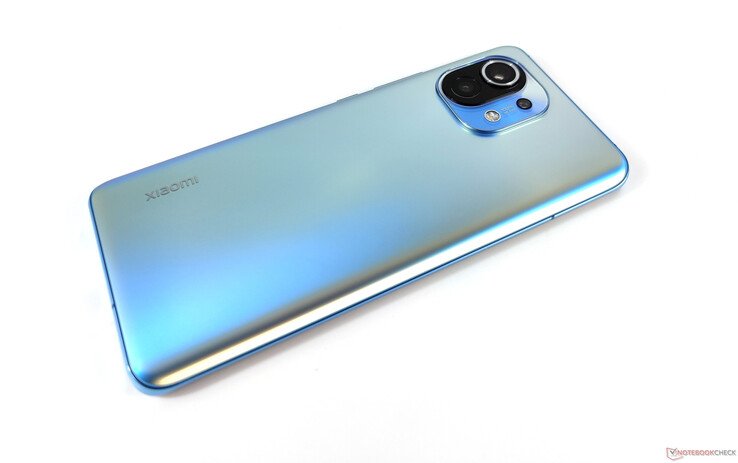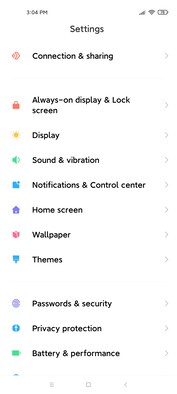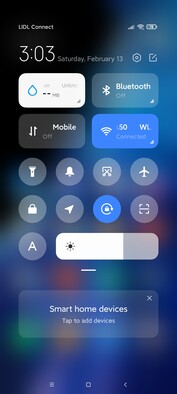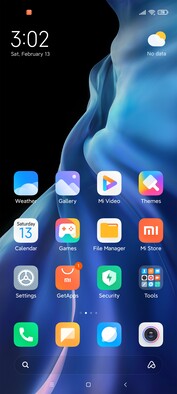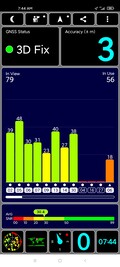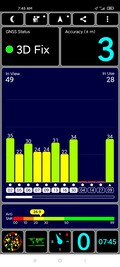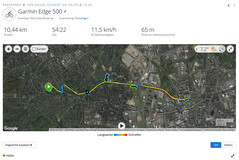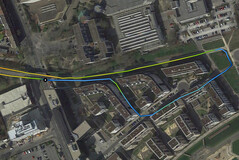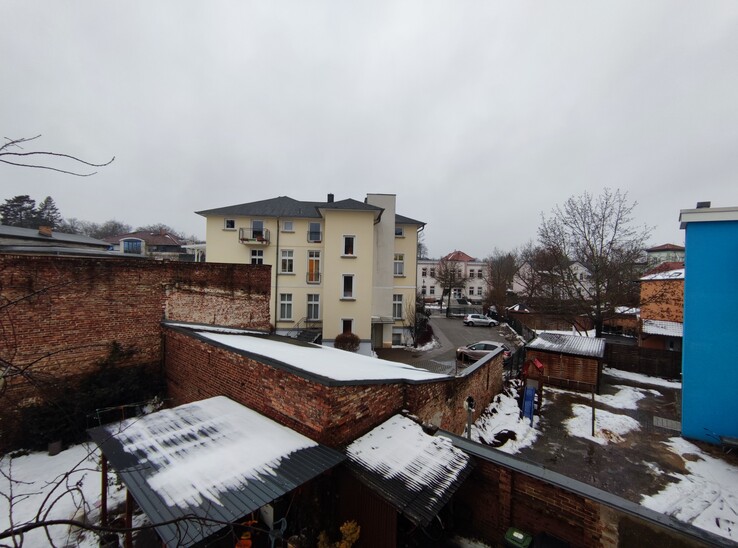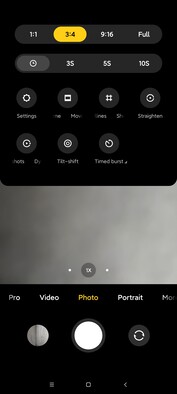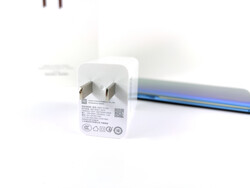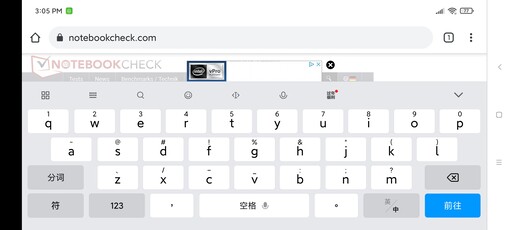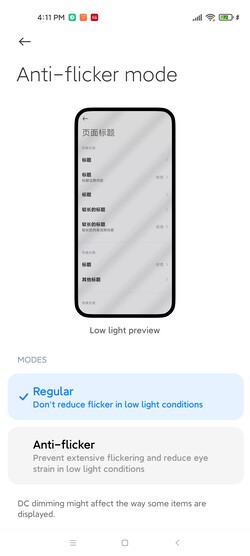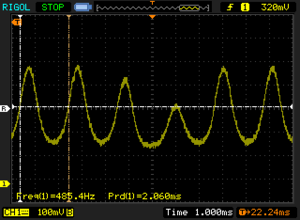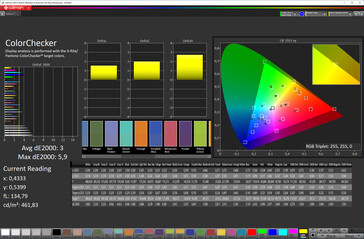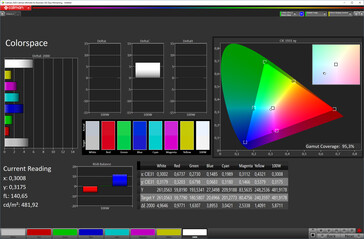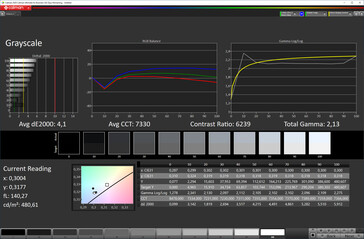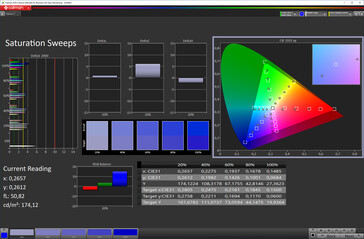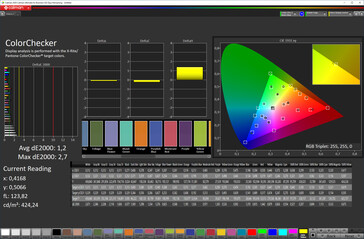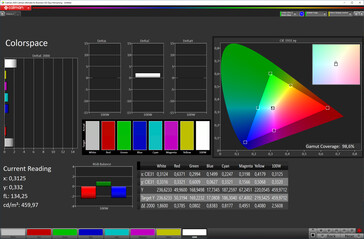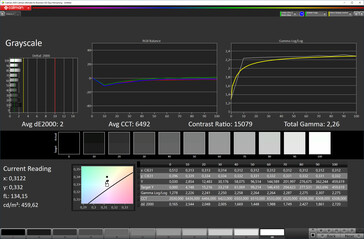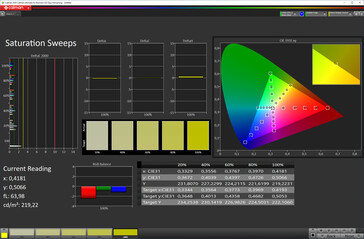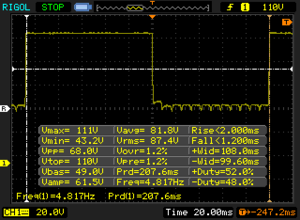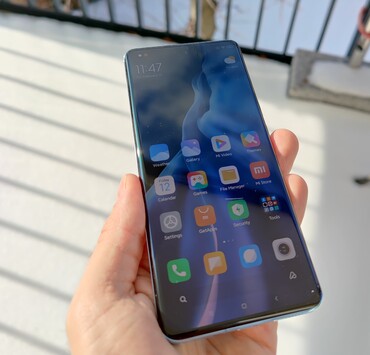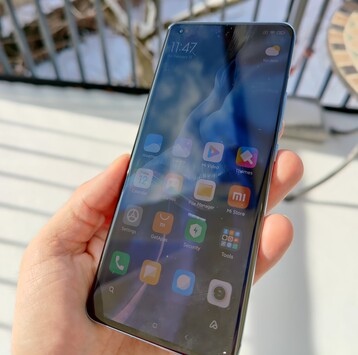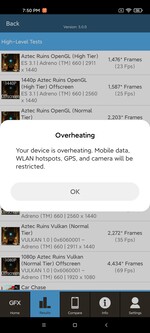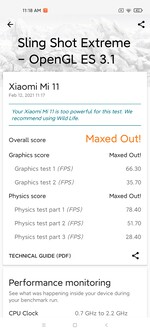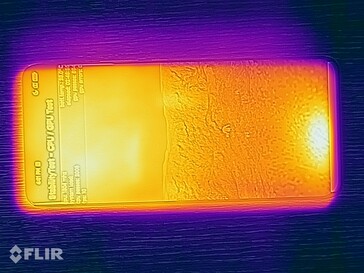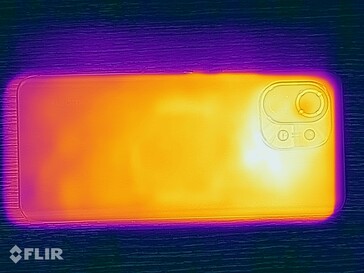Xiaomi Mi 11 review: Strong flagship smartphone with limitations

The Mi 11, which was introduced in December last year and kicked off with a new new sales record in China, is the first flagship smartphone with the brand-new Snapdragon 888. Besides the best Qualcomm SoC at the moment, the Mi 11 also sets standards within the smartphone series in terms of the display. The Chinese manufacturer is featuring a Super AMOLED panel with a resolution of 1440p for the first time in its Mi series, and the refresh rate has also been increased to 120 Hz compared with the predecessor. In addition, the 6.81-inch 10-bit OLED panel is expected to get very bright at 1,500 nits - similar to the brightness of Samsung's latest flagship.
The Mi 11 is priced much lower in China than in Germany. With 8 GB of LPDDR5 RAM and 128 GB of UFS 3.1 storage, the cheapest version of the Mi smartphone is available as an import for about 580 Euros (~$703) (among others, from our lender Trading Shenzhen). Xiaomi charges a premium of almost 300 Euros (MSRP: 799 Euros (~$968)) for the European model, but the power adapter is included. The top version with 256 GB of storage will set prospective buyers back almost 900 Euros (~$1,091). A version with 12 GB of RAM, like the one in China, will probably be unavailable in Germany.
Possible contenders in comparison
Rating | Date | Model | Weight | Drive | Size | Resolution | Price |
|---|---|---|---|---|---|---|---|
| 87.3 % v7 (old) | 02 / 2021 | Xiaomi Mi 11 SD 888 5G, Adreno 660 | 196 g | 128 GB UFS 3.1 Flash | 6.81" | 3200x1440 | |
| 88.5 % v7 (old) | 04 / 2020 | OnePlus 8 Pro SD 865, Adreno 650 | 199 g | 256 GB UFS 3.0 Flash | 6.78" | 3168x1440 | |
| 89.4 % v7 (old) | 04 / 2020 | Huawei P40 Pro Kirin 990 5G, Mali-G76 MP16 | 209 g | 256 GB UFS 3.0 Flash | 6.58" | 2640x1200 | |
| 84.6 % v7 (old) | 10 / 2020 | Google Pixel 5 SD 765G, Adreno 620 | 151 g | 128 GB UFS 2.1 Flash | 6.00" | 2340x1080 | |
| 83.4 % v7 (old) | 10 / 2020 | Oppo Reno4 Pro SD 765G, Adreno 620 | 172 g | 256 GB UFS 2.1 Flash | 6.50" | 2400x1080 | |
| 89.6 % v7 (old) | 02 / 2021 | Samsung Galaxy S21+ Exynos 2100 5G, Mali-G78 MP14 | 200 g | 128 GB UFS 3.1 Flash | 6.70" | 2400x1080 |
Case - Xiaomi smartphone with punch hole
The Mi 11's glass and aluminum case convinces with its very good build quality. The physical buttons can be haptically distinguished well from each other; they are comfortably placed and have a well-defined pressure point. Despite the relatively high battery capacity of 4,600 mAh, the Mi 11 is only 8 mm thin, and it's available (in China) in three colors: Black, silver, and light blue. There's also a "Smokey Purple" color version and a brown leather variant as well as a "Signature Edition" with the signature of Xiaomi's co-founder Lei Jun. In Germany, Mi 11 buyers will only be able to enjoy the "Midnight Gray" and "Horizon Blue" versions (at first), but the "Signature Edition" is supposed to follow.
The curved edges of the Gorilla Glass 5 back and the slim profile make the Xiaomi smartphone feel good in the hand - despite its size, which is accompanied by a 6.81-inch OLED panel. Like the Galaxy S21 Ultra, the Xiaomi smartphone equipped with Harman Kardon stereo speakers sports Gorilla Glass 7 "Victus" at the front. The slightly curved panel is rounded on all four sides and is surrounded by very thin edges. The surface area ratio between the display and the front of the device is a very good 91.4%. Consequently, the surface is used efficiently.
The Mi 11 doesn't have an official IP certification. Xiaomi has not stated whether the current Mi flagship has a P2i nanocoating, like the Mi 10 generation, making it at least protected against splashing water.
Connectivity - The Mi 11 measures heart rate
As is typical for OLEDs, the Mi 11 has an always-on function for notifications, and the fingerprint reader underneath the AMOLED panel can also be used as a heart rate monitor. Peripheral devices can be connected via the USB port using an OTG adapter. However, the USB Type-C port only supports the 2.0 standard.
The internal UFS 3.1 storage of our review sample has a capacity of 128 GB, whereby the user only has 105 GB available out of the box. It's not possible to expand the dual-SIM smartphone's storage via a microSD card.
The wireless transmission of display content to an external monitor via Miracast is also supported. Due to the reported Widevine DRM Level 1 availability, streaming content can be viewed in HD quality, even in the Chinese version of the Mi 11.
Software - Xiaomi smartphone with MIUI 12
Google's Android 11 is used as the operating system, and the security patches are at the level of January 2021. The manufacturer's MIUI 12.0.12 in-house user interface runs on top of that. MIUI 12's user interface is more reminiscent of Apple's iOS than of the underlying Android operating system with its separate notification center, the app switcher, and the control center's design, but it offers a lot of customization options and a well-optimized system interface.
Users who buy the Xiaomi Mi 11 in Germany will get Google services including the Play Store preinstalled out of the box. However, it should be noted that the software doesn't come with Google services or in the German language by default when importing the Chinese version. Instead, Chinese services, some advertisements, and Xiaomi's own services are used, and a large number of Chinese apps is preinstalled. A subsequent installation of Google mobile services is possible without any problems, but some apps can't be installed due to the lack of certification.
Communication and GPS - Xiaomi phone with fast WLAN
With Wi-Fi 6E and multi-user MIMO, the Mi 11 offers a very good configuration for the home WLAN, but this only provides very high transfer rates to a limited extent in a domestic network. In combination with our Netgear Nighthawk AX12 reference router, the Xiaomi phone is quite unstable, and transfer rates are "only" about 520 Mb/s on average for sending data, which is still very good, but it could be improved for a smartphone in this price range, especially since our test sample can't establish a connection with routers in VHT160.
When it comes to communication modules, Xiaomi opts for a dual-SIM mode, 5G, and NFC for near-field communication. It should be noted that the CN version doesn't have a "Play Protection Certified" status, which means that Google Pay shouldn't work. While the Snapdragon 865 still had to rely on a separate 5G modem, the chipset in the Mi 11 has integrated the new X60 modem RF system based on the 5-nanometer manufacturing technology. This also enables the Bluetooth 5.2 functionality that the Mi 11 is equipped with.
Besides 5G, the Mi smartphone supports access to a total of 20 LTE bands - all LTE frequencies relevant for Germany, including LTE bands 20 and 28, are covered even by the version from China this year.
The current position is determined using the main satellite systems: Dual-band GPS, GLONASS, and dual-band Galileo as well as Beidou. The satellite signal outdoors is obtained quickly with an accuracy of about 4 meters. Even indoors, the Mi 11 is able to determine its position quite fast.
In order to be able to assess the positioning accuracy of our test device in practice, we simultaneously log a route with the Garmin Edge 500 GPS bike computer for comparison purposes. The deviations are small, so that there are only about 160 meters between the Xiaomi flagship and the navigation device at the end of the 10.5-kilometer test route. The detailed course of the GPS tracking is also convincing with a precise location accuracy.
Telephone and call quality - Mi 11 with VoLTE
The call quality of the Xiaomi phone is very good, and the communication abilities via Skype are also convincing thanks to the Mi 11's two microphones. We didn't experience any annoying dropouts or reception problems during our calls with the Mi 11. Voices are reproduced clearly, and the person we talked to also characterized ours as being very clear.
The Xiaomi smartphone also supports standards like VoLTE or WLAN calls.
Cameras - Xiaomi smartphone with triple-camera setup
The Mi 11's camera setup consists of an optically stabilized 108 MP main camera and a 13 MP ultra wide-angle lens with an f/2.4 aperture, as well as a 5 MP portrait camera that primarily serves as a macro camera and for portrait shots. In terms of zoom skills, you have to make compromises with the Mi 11 in the absence of a dedicated lens with a high equivalent focal length. Accordingly, distant subjects are captured blurrily and with little detail - there's still room for the Pro and Ultra models of the Mi 11 generation in this regard.
Photos are taken with 4:1 pixel-binning by default and are very nice to look at. However, at an MSRP of just under 800 Euros (~$969) in Germany, we have to apply much higher standards than in the Mi 11's homeland. We find the slight sharpness deficits in the edges of the pictures as well as the somewhat low details to be suboptimal in this price range. Especially in very low light, a considerable amount of blurriness predominates with the Xiaomi phone. Thanks to the f/1.85 aperture and the large sensor, the illumination as well as the light sensitivity are very good. However, Samsung has shown in the course of last year that you can still achieve a lot of quality through software updates when it comes to Samsung sensors.
The ultra wide-angle lens with a relatively wide field of view of 123° offers a very decent image quality, but it's affected by artifacts and a clearly visible lack of sharpness in the edges. Nevertheless, the image details and dynamics as well as the color reproduction are convincing, especially when looking at the wide-angle pictures taken with the iPhone 12 Pro and the Huawei Mate 40 Pro. However, noise quickly sets in with increasing darkness due to the slower maximum aperture.
When it comes to videos, we didn't find the new Super Night Scene video mode in the settings, where AI algorithms are meant to ensure good low-light video quality. However, 8K video recording and HDR videos are supported. Video quality is good but not market-leading. Moreover, the inability to switch lenses during an active recording will probably be a bit annoying for some users.
The 20 MP front-facing camera in the display hole reveals solid photography capabilities in daylight, but the selfies would've benefited from slightly higher sharpness. The Mi series' front-facing camera can still only record videos in Full HD resolution (1920x1080 pixels) at up to 30 frames per second.
Image comparison
Choose a scene and navigate within the first image. One click changes the position on touchscreens. One click on the zoomed-in image opens the original in a new window. The first image shows the scaled photograph of the test device.
Wide-angleWide-angleLow-lightUltra wide-angle5x zoomWe subject the rear-facing main camera to further tests under controlled light conditions. With the ColorChecker Passport, we analyze the color reproduction of the 108 MP lens in comparison to the actual reference colors. We make one measurement in full studio lighting and one at a light intensity of 1 lux.
The colors are well reproduced with the Mi 11, and the deviations don't reveal any real weaknesses. Compared with the reference colors, the phone displays colors brighter than they are, which is typical for smartphones. Image sharpness is quite decent in our test chart. However, the edges of the image are not entirely sharp, and they're a bit angular in some spots.
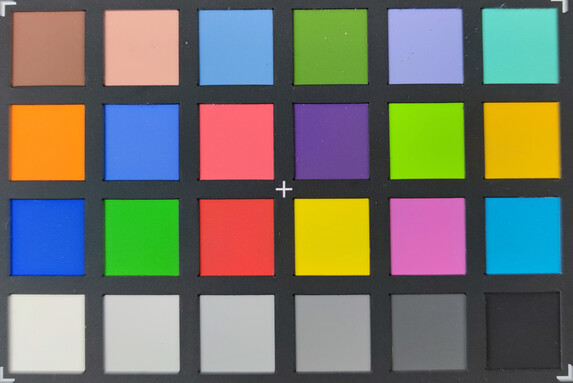

Accessories and warranty - Mi 11 with power adapter in Germany
Besides the Xiaomi smartphone itself, a USB cable, a protective case, a USB Type-C to 3.5 mm adapter, and a 55-watt power adapter are included in the box. As you might already know, there's no longer a charger in the box of the Chinese variant this year.
The warranty period is 12 months. With our import device, provided by TradingShenzhen, there's the option to send the device to a German shipping address in case of a warranty claim. As a result, a time-consuming shipping to China wouldn't be necessary.
Input devices and handling - Xiaomi Mi 11 with 480 Hz touch-sampling rate
It's possible to unlock the screen using biometric identification via fingerprint or facial recognition. The optical fingerprint scanner underneath the OLED panel responds reliably, but it sometimes takes a while until the finger is recognized. The sensor's recognition rate is very good, though. The face unlock function works reliably as well, but this option is unsafe due to the use of the front-facing camera.
Not only is the refresh rate (120 Hz) very high but also the touchscreen's sampling rate (480 Hz), resulting in inputs being implemented very smoothly on the 6.81-inch OLED panel. We also like the vibration system very much. The "linear Z-axis" vibration motor in the Mi 11 provides crisp feedback and operates at a high quality level.
Display - AMOLED DotDisplay in the Mi 11 at 1440p
The 6.81-inch AMOLED screen achieves a high brightness of 845 cd/m² in our measurements with homogeneous illumination. We also check the brightness with an evenly distributed ratio of dark to bright areas (APL50) in our test. We can also determine a very high brightness of 1,180 cd/m² here. Even the APL10 test (1,271 cd/m²) doesn't quite reach Xiaomi's specifications (1,500 nits), but the brightness is absolutely sufficient for HDR content either way.
While Samsung has taken a step backwards after several years in terms of resolution in its "cheap" flagship smartphones S21 and S21+, Xiaomi finally brings WQHD+ to the Mi phones. Whether every user needs the 3200x1440 pixels remains to be seen, but digital content is displayed very sharply with the Mi 11, and the high refresh rate of 120 fps is also at flagship level.
The Xiaomi smartphone uses pulse width modulation (PWM) at a high frequency of 257.7-485.4 Hz for brightness control. A DC dimming mode is also available; we measured 119-122 Hz here.
| |||||||||||||||||||||||||
Brightness Distribution: 98 %
Center on Battery: 840 cd/m²
Contrast: ∞:1 (Black: 0 cd/m²)
ΔE ColorChecker Calman: 1.2 | ∀{0.5-29.43 Ø4.78}
ΔE Greyscale Calman: 2 | ∀{0.09-98 Ø5}
98.6% sRGB (Calman 2D)
Gamma: 2.26
CCT: 6492 K
| Xiaomi Mi 11 LED DotDisplay, 3200x1440, 6.8" | OnePlus 8 Pro AMOLED, 3168x1440, 6.8" | Huawei P40 Pro OLED, 2640x1200, 6.6" | Google Pixel 5 OLED, 2340x1080, 6" | Oppo Reno4 Pro AMOLED, 2400x1080, 6.5" | Samsung Galaxy S21+ Dynamic AMOLED 2X, 2400x1080, 6.7" | |
|---|---|---|---|---|---|---|
| Screen | 19% | -5% | 3% | -81% | -13% | |
| Brightness middle (cd/m²) | 840 | 796 -5% | 584 -30% | 635 -24% | 790 -6% | 814 -3% |
| Brightness (cd/m²) | 845 | 779 -8% | 576 -32% | 636 -25% | 789 -7% | 814 -4% |
| Brightness Distribution (%) | 98 | 94 -4% | 95 -3% | 97 -1% | 95 -3% | 97 -1% |
| Black Level * (cd/m²) | ||||||
| Colorchecker dE 2000 * | 1.2 | 0.68 43% | 1.1 8% | 0.8 33% | 2.8 -133% | 2 -67% |
| Colorchecker dE 2000 max. * | 2.7 | 1.55 43% | 2.3 15% | 2.2 19% | 7.7 -185% | 3.6 -33% |
| Greyscale dE 2000 * | 2 | 1.1 45% | 1.8 10% | 1.7 15% | 5 -150% | 1.4 30% |
| Gamma | 2.26 97% | 2.237 98% | 2.16 102% | 2.23 99% | 2.29 96% | 2.12 104% |
| CCT | 6492 100% | 6310 103% | 6355 102% | 6492 100% | 6716 97% | 6568 99% |
* ... smaller is better
Screen Flickering / PWM (Pulse-Width Modulation)
| Screen flickering / PWM detected | 485.4 Hz | ≤ 99 % brightness setting | |
The display backlight flickers at 485.4 Hz (worst case, e.g., utilizing PWM) Flickering detected at a brightness setting of 99 % and below. There should be no flickering or PWM above this brightness setting. The frequency of 485.4 Hz is relatively high, so most users sensitive to PWM should not notice any flickering. However, there are reports that some users are still sensitive to PWM at 500 Hz and above, so be aware. In comparison: 53 % of all tested devices do not use PWM to dim the display. If PWM was detected, an average of 8108 (minimum: 5 - maximum: 343500) Hz was measured. | |||
The analysis performed using the spectrophotometer and the CalMAN software results in very low average Delta E deviations relative to the sRGB color space (profile: Original) in the Mi smartphone, with the ideal range being comprised of values below 3. The color temperature of 6,492 K is also spot on compared to the ideal value of 6,500 K. The color spaces that we measured (sRGB, P3) are almost completely covered by the OLED panel. Moreover, we can't really detect a color tint.
Display Response Times
| ↔ Response Time Black to White | ||
|---|---|---|
| 3.2 ms ... rise ↗ and fall ↘ combined | ↗ 1.6 ms rise | |
| ↘ 1.6 ms fall | ||
| The screen shows very fast response rates in our tests and should be very well suited for fast-paced gaming. In comparison, all tested devices range from 0.1 (minimum) to 240 (maximum) ms. » 13 % of all devices are better. This means that the measured response time is better than the average of all tested devices (20.2 ms). | ||
| ↔ Response Time 50% Grey to 80% Grey | ||
| 3.2 ms ... rise ↗ and fall ↘ combined | ↗ 2 ms rise | |
| ↘ 1.2 ms fall | ||
| The screen shows very fast response rates in our tests and should be very well suited for fast-paced gaming. In comparison, all tested devices range from 0.165 (minimum) to 636 (maximum) ms. » 12 % of all devices are better. This means that the measured response time is better than the average of all tested devices (31.6 ms). | ||
Performance - Xiaomi phone with Snapdragon 888
The latest high-end chipset from Qualcomm that is installed in the Mi 11 is based on the new Kryo 680 CPU unit. It integrates a fast "Prime Core" based on the Arm Cortex-X1 architecture with a clock speed of up to 2.84 GHz, three fast Cortex-A78-based performance cores (2.42 GHz), and four Arm Cortex-A55 cores with a maximum clock speed of 1.8 GHz. This is supposed to give the Snapdragon 888 a performance increase of 15% compared to the predecessor. Besides the CPU unit, the chipset has a Qualcomm Adreno 660 as graphics processor as well as a Hexagon 780 computing unit and the Qualcomm Sensing Hub for AI applications.
In our benchmark package, the Snapdragon 888 in the Mi 11 shows its strength - in a well-cooled state, that is. During prolonged load, the Xiaomi phone reports an overheating protection state, and the benchmarks are aborted. But even without crashes due to overheating, evaluating the device's performance is quite difficult, because the results of the same benchmark show large variations.
Compared to the Exynos 2100 in the Samsung Galaxy S21 Ultra, the Snapdragon 888 performs on par with Samsung's flagship SoC, but it's difficult to determine the "true" performance gap due to the throttling of the Mi 11. In the graphics tests, the Mali-G78 MP14 is also on par with the Adreno 660 - at least for the most part. In the GFX Bench's T-Rex test, the Mi 11's Offscreen scores in particular are very strong.
The Mi 11 leaves an excellent impression in everyday use, because the thermal problems are hardly an issue here. System performance is outstanding, and application load times are very fast. This is also due to the fast read and write speeds of the UFS storage. However, these are relatively low for the 3.1 standard considering that the Snapdragon 888 is now supposed to support the full bandwidth.
| AImark - Score v2.x (sort by value) | |
| Xiaomi Mi 11 | |
| Huawei P40 Pro | |
| Samsung Galaxy S21+ | |
| Apple iPhone 12 Pro Max | |
| Samsung Galaxy S21 Ultra | |
| Average Qualcomm Snapdragon 888 5G (171404 - 264766, n=15) | |
| Jetstream 2 - 2.0 Total Score | |
| Average of class Smartphone (23.8 - 387, n=149, last 2 years) | |
| Average Qualcomm Snapdragon 888 5G (61.3 - 125.1, n=13) | |
| Xiaomi Mi 11 (Chrome 88) | |
| Huawei P40 Pro (Huawei Browser 10.1) | |
| Samsung Galaxy S21+ (Chrome 88.0.4324.152) | |
| OnePlus 8 Pro (Chrome 80) | |
| Google Pixel 5 (Chrome 86.0.4240.110) | |
| JetStream 1.1 - Total Score | |
| Average Qualcomm Snapdragon 888 5G (77 - 223, n=19) | |
| Xiaomi Mi 11 (Chrome 88) | |
| Samsung Galaxy S21+ (Chrome 88.0.4324.152) | |
| Huawei P40 Pro (Huawei Browser 10.1) | |
| OnePlus 8 Pro (Chrome 80) | |
| Google Pixel 5 (Chrome 86.0.4240.110) | |
| Oppo Reno4 Pro (Chrome 86) | |
| Speedometer 2.0 - Result 2.0 | |
| Average of class Smartphone (15.2 - 643, n=122, last 2 years) | |
| Samsung Galaxy S21+ (Chrome 88.0.4324.152) | |
| Average Qualcomm Snapdragon 888 5G (46.9 - 121, n=12) | |
| Huawei P40 Pro (Huawei Browser 10.1) | |
| OnePlus 8 Pro (Chome 80) | |
| Xiaomi Mi 11 (Chrome 88) | |
| Google Pixel 5 (Chrome 86.0.4240.110) | |
| WebXPRT 3 - Overall | |
| Average of class Smartphone (38 - 380, n=31, last 2 years) | |
| Average Qualcomm Snapdragon 888 5G (103 - 182, n=18) | |
| Xiaomi Mi 11 (Chrome 88) | |
| OnePlus 8 Pro (Chrome 80) | |
| Samsung Galaxy S21+ (Chrome 88.0.4324.152) | |
| Google Pixel 5 (Chrome 86.0.4240.110) | |
| Oppo Reno4 Pro (Chrome 86) | |
| Huawei P40 Pro | |
| Octane V2 - Total Score | |
| Average of class Smartphone (2228 - 121337, n=197, last 2 years) | |
| Average Qualcomm Snapdragon 888 5G (23491 - 47543, n=20) | |
| Samsung Galaxy S21+ (Chrome 88.0.4324.152) | |
| Xiaomi Mi 11 (Chrome 88) | |
| Huawei P40 Pro (Huawei Browser 10.1) | |
| OnePlus 8 Pro (Chrome 80) | |
| Google Pixel 5 (Chrome 86.0.4240.110) | |
| Oppo Reno4 Pro (Chrome 86) | |
| Mozilla Kraken 1.1 - Total | |
| Oppo Reno4 Pro (Chrome 86) | |
| Google Pixel 5 (Chrome 86.0.4240.110) | |
| OnePlus 8 Pro (Chrome 80) | |
| Huawei P40 Pro (Huawei Browser 10.1) | |
| Samsung Galaxy S21+ (Chrome 88.0.4324.152) | |
| Xiaomi Mi 11 (Chrome 88) | |
| Average Qualcomm Snapdragon 888 5G (891 - 1841, n=20) | |
| Average of class Smartphone (257 - 28190, n=154, last 2 years) | |
* ... smaller is better
| Xiaomi Mi 11 | OnePlus 8 Pro | Huawei P40 Pro | Google Pixel 5 | Oppo Reno4 Pro | Samsung Galaxy S21+ | Average 128 GB UFS 3.1 Flash | Average of class Smartphone | |
|---|---|---|---|---|---|---|---|---|
| AndroBench 3-5 | -15% | -16% | -55% | -44% | 12% | -7% | 52% | |
| Sequential Read 256KB (MB/s) | 1615 | 1627 1% | 1775 10% | 851 -47% | 943 -42% | 1623 0% | 1569 ? -3% | 2228 ? 38% |
| Sequential Write 256KB (MB/s) | 754 | 730 -3% | 395.7 -48% | 190 -75% | 473.7 -37% | 1037 38% | 768 ? 2% | 1852 ? 146% |
| Random Read 4KB (MB/s) | 278.5 | 208.3 -25% | 228.1 -18% | 138.9 -50% | 159.4 -43% | 309.6 11% | 244 ? -12% | 296 ? 6% |
| Random Write 4KB (MB/s) | 289.3 | 197.7 -32% | 271.8 -6% | 155.9 -46% | 139.6 -52% | 283.3 -2% | 243 ? -16% | 339 ? 17% |
Games - Xiaomi phone with Adreno 660
The 3D performance of the Mi 11 is put through its paces with a few demanding games from the Play Store. In combination with the GameBench app, we log the frame rates during the gaming sessions.
Graphics-heavy games are consistently rendered at a stable 60 FPS in the best image quality; Xiaomi seems to limit the Mi 11 here. PUBG Mobile is also smoothly playable at a high 40 FPS in Ultra HD. Frame-rate drops aren't visible in the shooter game even in the highest graphics settings.
Not only is the Xiaomi phone suitable for gamers because of the new Adreno 660 GPU but also because of the very high touch-sampling rate of 480 Hz as well as Qualcomm's Game Quick Touch feature, which is meant to noticeably improve response times for touch inputs. The sensors and the OLED display responded impeccably in the test. In contrast to the benchmarks, heat development is absolutely kept within limits here.
Emissions - Mi 11 suffers from throttling
Temperature
The Mi 11's rear-facing glass case heats up relatively noticeably under permanent load. We usually use the battery test of the GFXBench app to check the internal heat development. The respective scenarios are run 30 times in a row, and both the battery status and frame rates are logged. However, we can't analyze the temperature behavior of the Qualcomm SoC, because the test is terminated after a relatively short time due to overheating protection.
Nevertheless, high frame-rate fluctuations can be identified based on the results of the individual tests. The Mi 11 sometimes throttles up to 50% under CPU-intensive load in the T-Rex test. The native refresh rate limits the Onscreen rates with optimal cooling, but we only reach 60 fps when we run the benchmark several times.
However, heat development is (probably) hardly a real problem in everyday use - under "normal" load, such as a 30-minute gaming session or several 8K videos in a row, heat development is clearly noticeable, but we don't observe any performance losses. The Mi 11's stability in the Wild Life stability stress test is also very decent. Whether this is also the case in summer temperatures is questionable at the least.
| 3DMark - Wild Life Stress Test Stability | |
| Huawei P40 Pro | |
| Google Pixel 5 | |
| Xiaomi Mi 11 | |
| Samsung Galaxy S21+ | |
(+) The maximum temperature on the upper side is 37.6 °C / 100 F, compared to the average of 35.2 °C / 95 F, ranging from 21.9 to 247 °C for the class Smartphone.
(+) The bottom heats up to a maximum of 37.5 °C / 100 F, compared to the average of 34 °C / 93 F
(+) In idle usage, the average temperature for the upper side is 28.2 °C / 83 F, compared to the device average of 32.9 °C / 91 F.
Speakers
The Mi 11 has a symmetrical dual-speaker system on the top and bottom of the case. The stereo speakers tuned by Harman Kardon offer a very nice sound. Music output hardly features any bass, but it has very linear highs and mids in return. Drops are barely visible in the Pink Noise diagram, even with super high tones. Currently, it doesn't get much better in the smartphone segment.
Xiaomi didn't include an audio jack in the Mi 11, but music playback via the USB port offers a clean sound. Users who want to use wireless headphones can also enjoy aptX, AAC, LHDC, and LDAC support.
Xiaomi Mi 11 audio analysis
(+) | speakers can play relatively loud (86.8 dB)
Bass 100 - 315 Hz
(-) | nearly no bass - on average 26% lower than median
(±) | linearity of bass is average (9.5% delta to prev. frequency)
Mids 400 - 2000 Hz
(+) | balanced mids - only 4.5% away from median
(+) | mids are linear (5.3% delta to prev. frequency)
Highs 2 - 16 kHz
(+) | balanced highs - only 4.5% away from median
(+) | highs are linear (2.3% delta to prev. frequency)
Overall 100 - 16.000 Hz
(±) | linearity of overall sound is average (17.8% difference to median)
Compared to same class
» 14% of all tested devices in this class were better, 9% similar, 77% worse
» The best had a delta of 11%, average was 35%, worst was 134%
Compared to all devices tested
» 35% of all tested devices were better, 8% similar, 57% worse
» The best had a delta of 4%, average was 24%, worst was 134%
Samsung Galaxy S21+ audio analysis
(+) | speakers can play relatively loud (87.8 dB)
Bass 100 - 315 Hz
(-) | nearly no bass - on average 27.7% lower than median
(±) | linearity of bass is average (11.1% delta to prev. frequency)
Mids 400 - 2000 Hz
(±) | reduced mids - on average 5.3% lower than median
(+) | mids are linear (4.9% delta to prev. frequency)
Highs 2 - 16 kHz
(+) | balanced highs - only 4.2% away from median
(+) | highs are linear (2% delta to prev. frequency)
Overall 100 - 16.000 Hz
(±) | linearity of overall sound is average (18.7% difference to median)
Compared to same class
» 21% of all tested devices in this class were better, 9% similar, 69% worse
» The best had a delta of 11%, average was 35%, worst was 134%
Compared to all devices tested
» 42% of all tested devices were better, 8% similar, 50% worse
» The best had a delta of 4%, average was 24%, worst was 134%
Battery life - Xiaomi Mi 11 with 50-watt wireless charging
Energy consumption
The Mi 11's 4,600 mAh battery charges at 55 watts via USB-C PD and wirelessly at a maximum of 50 watts. Qi-enabled devices can also be charged wirelessly at 10 watts with the reverse wireless charging function. With the 55-watt power adapter's fast charging technology, the Mi 11 is fully recharged in about 40 minutes when the battery is completely depleted.
Power consumption isn't especially efficient. Consumption peaks of almost 12 watts under load in particular are comparatively high.
| Off / Standby | |
| Idle | |
| Load |
|
Key:
min: | |
| Xiaomi Mi 11 4600 mAh | OnePlus 8 Pro 4510 mAh | Huawei P40 Pro 4200 mAh | Google Pixel 5 4080 mAh | Oppo Reno4 Pro 4000 mAh | Samsung Galaxy S21+ 4800 mAh | Average Qualcomm Snapdragon 888 5G | Average of class Smartphone | |
|---|---|---|---|---|---|---|---|---|
| Power Consumption | -33% | 37% | 58% | 14% | 27% | 18% | 16% | |
| Idle Minimum * (Watt) | 1.57 | 2.2 -40% | 0.92 41% | 0.69 56% | 0.95 39% | 0.74 53% | 1.066 ? 32% | 0.842 ? 46% |
| Idle Average * (Watt) | 1.92 | 3.3 -72% | 1.41 27% | 0.82 57% | 2.49 -30% | 1.27 34% | 1.58 ? 18% | 1.439 ? 25% |
| Idle Maximum * (Watt) | 1.94 | 3.7 -91% | 1.47 24% | 0.85 56% | 2.58 -33% | 1.33 31% | 1.733 ? 11% | 1.624 ? 16% |
| Load Average * (Watt) | 6.32 | 5.9 7% | 3.35 47% | 2.73 57% | 3.52 44% | 6.32 -0% | 5.46 ? 14% | 7.03 ? -11% |
| Load Maximum * (Watt) | 11.65 | 8.3 29% | 6.37 45% | 4.4 62% | 5.9 49% | 9.61 18% | 9.79 ? 16% | 11.3 ? 3% |
* ... smaller is better
Battery life
The Xiaomi flagship's battery runtimes are below average; they can only really convince in our video battery test. Our comparison devices can be compared best at an adjusted display brightness of 150 cd/m². The Mi 11 is at the lower end of our comparison field with just under 9 hours in our WLAN test - reducing the panel to 1080p and 60 Hz in the settings menu provides about 2 hours more.
Besides the inefficient cooling of the Snapdragon 888, one of the reasons for the relatively low endurance is the WLAN modem, because the Xiaomi phone lasts almost twice as long in our continuous video loop with the WLAN disabled.
| Xiaomi Mi 11 4600 mAh | OnePlus 8 Pro 4510 mAh | Huawei P40 Pro 4200 mAh | Google Pixel 5 4080 mAh | Oppo Reno4 Pro 4000 mAh | Samsung Galaxy S21+ 4800 mAh | |
|---|---|---|---|---|---|---|
| Battery runtime | 50% | 20% | 64% | 80% | 33% | |
| Reader / Idle (h) | 19.1 | 35.1 84% | 24.6 29% | 37.4 96% | 29.7 55% | |
| H.264 (h) | 16.2 | 17.1 6% | 19 17% | 24.4 51% | 19.6 21% | |
| WiFi v1.3 (h) | 8.8 | 15.4 75% | 12.4 41% | 13.5 53% | 15.8 80% | 10.9 24% |
| Load (h) | 3.6 | 4.9 36% | 3.3 -8% | 5.6 56% | 4.7 31% |
Pros
Cons
Verdict on the Xiaomi Mi 11 - Still very attractive in relation to the competition
The latest offspring of the Mi series is a very good smartphone, but the expectations for Xiaomi's flagship have also increased with the price strategy that has been adjusted since last year. Regardless of the very high heat development in some benchmark programs, which (probably) shouldn't play a major role in everyday use, the Mi 11 has a few areas with potential for improvement.
Very good but, unfortunately, no longer cheap.
The WLAN modem in the Xiaomi phone is quite erratic and consumes a lot of power, resulting in rather suboptimal runtimes, and the camera quality also leaves room for software updates. Maybe Xiaomi should have been less focused on marketing the 108 MP camera here, because we liked the 48 MP lens of the Mi 10 Ultra better in our test. The lack of an IP rating and the USB 2.0 standard don't really fit the MSRP of almost 800 Euros (~$969) either.
Nonetheless, the Mi 11 (still) offers a lot of smartphone for the money, especially in relation to the prices of the Galaxy S21 smartphones and their features. Above all, the very bright, high-resolution AMOLED panel in combination with the fast-charging features of the Xiaomi phone are hard to find in this price range.
Price and availability
The support of Widevine L1 and LTE band 20 as well as the low prices in China make the CN version of the Mi 11 very attractive this year. The import prices of the Mi 11 start at around 580 Euros (~$703). In addition, the Xiaomi Mi 11 is officially coming to the UK in March 2021. If you're in the United Stated, where this smartphone is not officially sold, you can keep your eyes out for the Mi 11 in online stores like newegg, Amazon or ebay.
Xiaomi Mi 11
- 08/31/2022 v7 (old)
Marcus Herbrich





